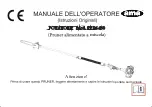
WARNING! ENSURE THE mACHINE IS DISCONNECTED FROm THE mAINS POWER SUPPLY bEFORE CARRYING OUT ANY mAINTENANCE.
6.1.
Changing tyres
Eventually the tyres on the bandsaw wheels will wear due to the constant contact with the blade teeth.
Remove blade (see 4.1), lift the edge of the tyre with a small screwdriver and the tyre can be worked off the wheel easily. It is
recommended that both tyres be changed at the same time.
6.2. blades
If blade breaks, check for correct tension after fitting new blade. Also avoid over-working blade by keeping to a constant feed rate and
avoiding any side pressure.
6.3.
blade guides
Blade guides should be inspected regularly for wear or chipping. When replacing guides, replace all guides at the same time, both
upper and lower.
6.4.
Table insert
The insert should be inspected regularly and replaced if wear or damage is found.
6.5. bearings
All bearings used in the construction of the bandsaw and motor are sealed and lubricated for life.
6.6. Cleaning
Remove dust and chips from the inside of the bandsaw frequently. Open the wheel covers and use a brush or vacuum cleaner.
At the end of every work session, clean sawdust away from the motor vents.
6. mAINTENANCE
To switch saw on, press the green (I) ‘On’ button. Press the red (O) ‘Off’ button to turn saw off.
Adjust blade guide (fig.1 & 3.C) to just above the workpiece (3mm). Use both hands to feed workpiece to the blade. Use a steady
even pressure sufficient to keep blade cutting but no more. If needed, stop the saw and wait for blade to completely stop before
backing blade out of a cut.
5.1.
Rip sawing
Cutting wood with the grain. for best results use rip fence on left side of saw to guide workpiece. The table side guide scale shows
the distance between the blade and the left-hand edge of the workpiece.
5.2.
Cross cutting
To cut wood at right angles to the grain. This type of cut can be made freehand but using the mitre guide ensures accurate results.
The guide can also be adjusted up to a 45° angle to produce mitre cuts or compound cuts with the table tilted. Ensure the work is
held firmly against the table and against the face of the mitre guide.
WARNING!
Keep your fingers away from the blade, use the pushstick to push the last piece of work through.
5.3. Freehand
When freehand cutting, always feed the work slowly to follow your saw line. Ensure you do not drag the work off-line forcing the
blade sideways or twisting it. It may be helpful to make an initial rough cut about 5mm away from the line. for difficult curves which
may be too tight for the blade, make relief cuts on the face of the curve so that the waste wood will fall away as the final radius is cut.
5.4.
blade selection
5.4.1. There should be at least three saw teeth in contact with the workpiece at any one time during cutting. Therefore the thinner the
workpiece the higher the blade tpi required.
5.5.
bevel cutting
When bevel cutting with the table tilted always have the workpiece guide (fence or mitre) on the lower part of the table.
5.6.
Workpiece stability
Any workpiece which does not have a flat surface which will ensure stability on the saw table
must be
held in a suitable device which
will prevent rotation.
5. OPERATING INSTRUCTIONS
NoTE:
It is our policy to continually improve products and as such we reserve the right to alter data, specifications and component parts without prior notice.
ImPORTANT:
No liability is accepted for incorrect use of this product.
WARRANTY:
Guarantee is 12 months from purchase date, proof of which will be required for any claim.
INFORmATION:
for a copy of our latest catalogue and promotions call us on 01284 757525 and leave your full name and address, including postcode.
01284 757500
01284 703534
Sole UK Distributor, Sealey Group,
Kempson Way, Suffolk Business Park
,
Bury St. Edmunds, Suffolk,
IP32 7AR
www.sealey.co.uk
W e b
Original Language Version
SM1303, SM1304 Issue: 5 - 19/09/13






















